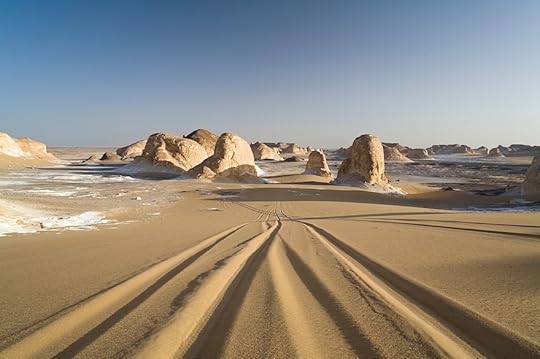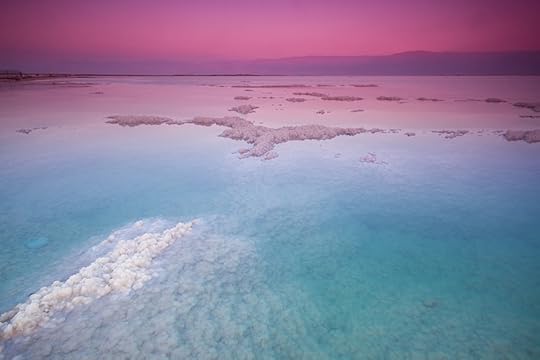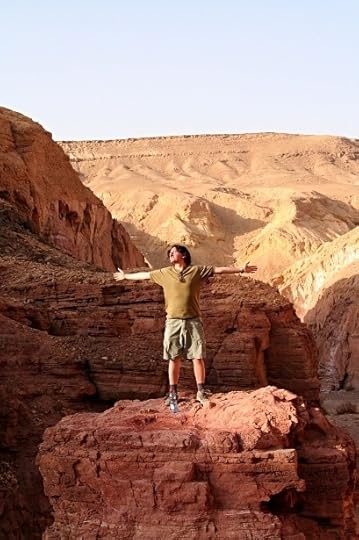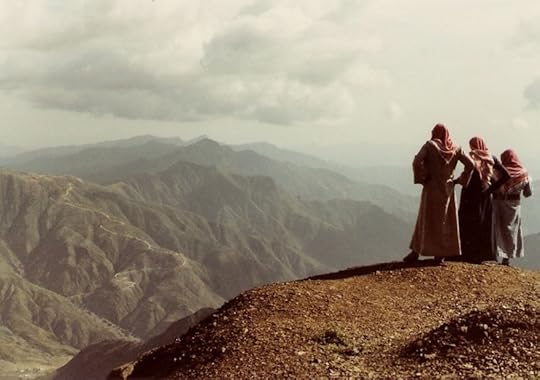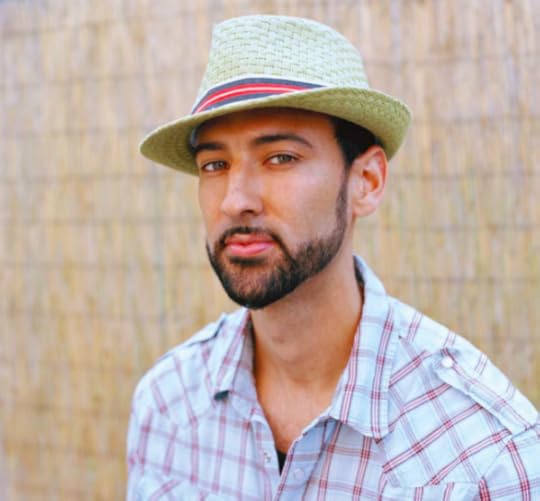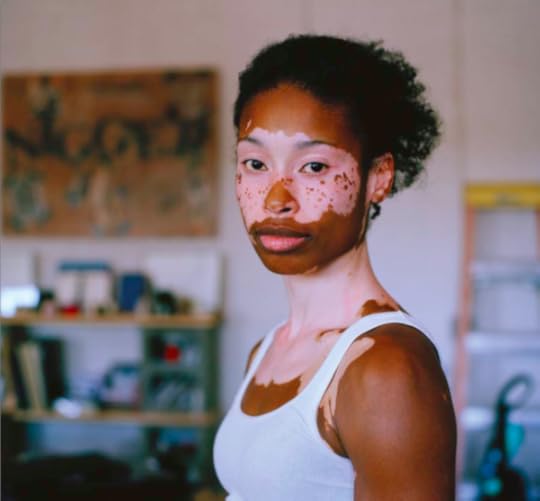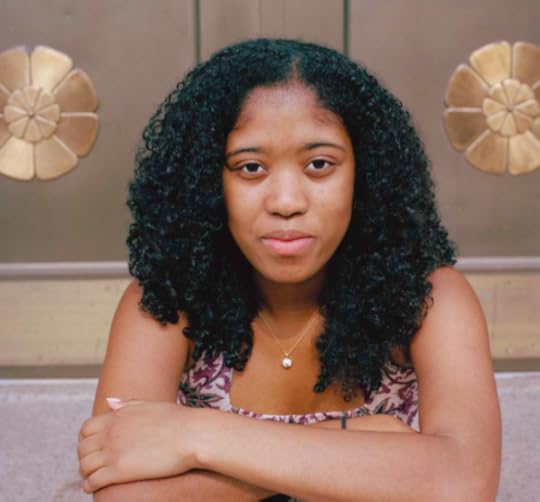Matador Network's Blog, page 2291
April 1, 2014
How to piss off a Belgian

Photo: Kevin Van den Panhuyzen
Ask if Brussels is in Germany.
Be completely oblivious of geography, history, and politics. Ignore the fact that it’s actually the capital of a country quite commonly referred to as “Belgium,” which declared its independence in 1830. Remind us that, indeed, not so long ago zie Germans did wander around within our country’s borders for a lengthy period of time.
Because we share borders with countries such as the Netherlands, Luxembourg, Germany, and France, it’s of course more than likely that we are actually merely a province.
Assume we all speak French.
After a lengthy discussion, during which we show you our passports, pinpoint Belgium on Google Maps, and finally have you convinced that the annexation to Germany did not happen…assume we all speak French.
Conveniently fail to acknowledge that about 60% of our citizens speak Dutch, along with more than 75,000 that speak German. Disregard the fact that it’s also quite common to be bilingual here. Ask if we’re sure Dutch is an actual language, or be amazed that it’s spoken outside of the Netherlands.
Tell us you really enjoy Belgian beers: Blue Moon, Flying Fish, Horny Devil…
Try to bond with us in a bar by telling us the story of that night out on the town when you tried several real Belgian Beers — not Belgian Style Beers, as the labels read. Be sure to be very confident — you surely knew what you were drinking, so who is this Belgian guy to claim it wasn’t genuine Belgian beer?
As you raise your pint of Blue Moon, become increasingly self-assured with every sip you take. Your beer is as Belgian as Leffe, Duvel, Stella Artois, and Westvleteren, no doubt about it. Continue to celebrate your new friendship, and confide in us that you think they all taste the same.
Pretend to be an expert on ‘Belgian waffles.’
Not only did your last trip to New York consist of exploring the Big Apple, you also tried Belgian waffles for the first time. There’s of course no difference between waffles from Liège or Brussels and those served at Wafels & Dinges. You had a great waffle, one with powdered sugar, whipped cream, and strawberries and/or chocolate.
But there was something missing, was there not? So when you got home, you decided to make the recipe even better by taking some of the traditional toppings and giving it that little bit of extra by adding layers of bacon and maple syrup. Not less is more — more is more. You even took a picture, which you now brazenly show us, expecting a thank you for improving on the namesake of our homeland.
Bring up the tax thing like you know what you’re talking about.
Remember that article in the newspaper about which countries have the highest total tax rate? The one that highlighted Belgium being almost 20% above the EU average? Also the same article that suggested your country is somewhere in the middle.
Well, now that you’ve got us, it must be time to mention how hard it already is for you, how you can’t imagine living like that with the government emptying your pockets. Pay absolutely no attention to our excellent healthcare system, and forget that we provide for the unemployed.
Ask about French Fries.
You’ve eaten mussels and French fries and you loved them — we all do. But why are they called French fries all over the world?
We always enjoy being reminded that one of our favorite dishes is associated with the French, despite the fact that we prepare our fries differently. Perhaps now is also the the time to mention how you always forget whether Brussels is situated in France or Germany… 
This post was published in its original form at Mr. Good Life and is reprinted here with permission.
The post How to piss off a Belgian appeared first on Matador Network.
Apply to be a Pokémon Master
IT’S AMAZING TO me that Pokémon is still relevant; I thought that 90s fad was put to rest, along with tamagotchis, and pogs. However, it looks like GoogleMaps has added a new feature in which people can zoom in on locations and catch Pokémon, in an effort to find an official Pokémon Master for this platform. It’s the next wave in augmented reality, and could land you a cushy job at one of the leading technology companies in the world.
Think you’ve got what it takes? Apply right from your cell phone. But you gotta catch ‘em all — you have until April 2, 2014, to find all 150 species, and be considered for the position. 
Happy April Fools, from the team at Matador Network!
The post JOB ALERT: Apply to be a Google Maps Pokémon Master appeared first on Matador Network.
5 things you learn living on a boat

Photo: Dave Keane
When your friend asks you to spend a winter with him, living on his 27ft Bristol and sailing through the Grenadine Islands in the Southern Caribbean, it doesn’t matter if you’ve barely paddled a canoe and an irrational fear of sharks keeps you out of most lakes. The answer to the question is yes.
So a month later, when you find yourself in the middle of the Atlantic with no land in sight, 50 nautical miles from where you started, heading into 13-knot winds and an approaching rainstorm, you might be clinging to the safety lines and trying not to vomit again. Your brain might feel like it’s bouncing around in an empty PBR can. Peering down into the cabin for escape might feel like peering down into the satanic depths of your own personal K-hole.
You’ll want to go home. To return to your long johns and your entire wheel of Brie, to your beanbag chair and your HBO Go account.
But boat life is a challenge and a long haul. Your only chance of escape is to stay put, to allow yourself to be weathered by the elements, the lack of rules, and the freedom. You’ll have to decide: Do I sail or do I sink?
And if you sail, you’ll learn.
1. Showers aren’t necessary.
It might be days before you notice that your cuticles have ripped down to your knuckles. Your skin is literally disintegrating from the lack of fresh water.
But you’re living on a boat in the Caribbean! You’re swimming every day! You’re reading three books a week! You’re choreographing an entire synchronized-swimming routine. And it’s Olympic quality! You don’t give a shit about how you smell. You’re busy.
Living on a boat allows you to let minor issues like cleanliness fall by the wayside. Maybe once a month, a torrential downpour will hit and you’ll grab some Dr. Bronner’s, get naked, and have a little baby Jesus shower on deck. There’s no such thing as ‘body shy.’ Look around. Every self-respecting boat person is doing it. And at this point, you’ve seen one too many 70-year-old, retired-expat penises to care. So scrub-a-dub-dub.
2. People living on land have a bathroom. You have the open ocean.
If you haven’t stepped into a shower stall in weeks, your ass probably hasn’t cozied onto a toilet seat in awhile either.
Sure, most boats will have heads. They’ll have odd pumping or pulling or sliding contraptions. And you’ll have to warn every snorkeler in a half-mile radius if you’re gonna deuce it because it might land on their head while they’re investigating some coral.
But you’re coasting in on the smallest lady in the harbor, and she doesn’t have much space to spare below deck. So it’s over the railing, sweetheart.
Boat life is personal, not always socially acceptable. And after a while you might start to enjoy your new habit of cutting out the middleman. The ocean is your own personal bidet! It might feel a little too fancy sometimes.
You’ll proudly make up a song with your captain that goes, “You go in the morning / I go at night / Society says it’s wrong / But to us it feels right.” And because you have nothing else to do, you’ll actually develop that song with more lyrics and perform it acoustically in front of your boat neighbors.
“Why does anyone use a toilet ever?” you’ll ask yourself aloud on an eight-hour sail to Bequia, as you brace yourself on a cleat and tinkle over the side. (The key to peeing while underway is to brace, squat, and lean with the boat. And to have a spotter. Always have a spotter.)
3. Boat life doesn’t always make you cool in real life.
You’re waking up every morning to the sun shining through the forward hatch. You’re free diving down to 16ft to make sure the anchor is secure. You’re rowing Rosie the rowboat a mile into shore every goddam day for ‘provisions.’ You might think this trip is making you pretty fucking cool. You’re probably wrong.
Just because you picked up an old beater guitar in Saint Lucia and stumbled through the first few chords of “Wish You Were Here” does not mean you’re going to be the next singer/songwriter back in the States. Just because you started a band with you, your captain, and that guy on the Oyster 29 across the way, and you called it Caribbean Stew for the Sailor’s Soul, and you got pretty bossy last Tuesday night at band practice, does not mean you guys are going to sign a record deal.
Get that through your head. Before you make the mistake of buying a drum, custom made from the trunk of a coconut tree and stretched with a real goatskin. And you’ve used that drum to pitter-patter along with a circle on Union Island, which has led you to believe that drumming is now your ‘thing.’
So you carry your 18lb drum through five flights back home, and you immediately bring it to a party. Only to realize the hard way that you’ve been playing “We Will Rock You” this whole time. Don’t let yourself make that mistake. It’s incredibly disappointing.
4. Boat life is a simple life.
Your daily schedule might sound like this: Wake up and lay around for 45 minutes. Eat a mango. Swim for a second. Float on your blowup donkey thing. Sample some marijuana. Attempt one pull-up over the railing. Fail. Think about what your life might be like if you had toned arms. Eat some variation of beans and rice. And so on and so on for all of eternity.
Before long, boat life will have you questioning why land life even exists. Why can’t we all just Waterworld it out here?
Back home on land, you have a schedule. You have a phone that rings. You have to answer people and tell them what you’re doing.
“I’m just sitting. Staring at my geranium plant,” you might say.
“Well, why?” they might say.
And then you have to come up with an answer for them. It’s all very annoying. Boat life doesn’t present those conversations. To get through a day on a boat, you just have to solve the basic riddles of survival.
How am I going to get myself to shore to buy a popsicle? I’m going to row my rowboat.
When am I going to sail to Grenada? In two days when the wind has died down to 5 knots.
How am I going to kill this bluefin tuna that I caught? I’m going to hit it over the head with my wench handle. Then I’m going to eat it.
5. You’re stronger than you know.
Now that you’ve spent your winter on a very small boat, living a very primitive and basic life, you’ll return home a happier and more resourceful person. As you jumped from island to island, inspiration followed you. You were greeted every day with the open arms of island culture, each community different and inviting and eager to welcome you.
You’re now a person in perpetual motion. You’ve learned how to maneuver the bow of a boat underway, how to use your weight to hoist her sails and secure her lines, and how to proudly sail onto anchor when everyone else is motoring in.
And in the middle of the night, in the middle of the ocean, thousands of miles from home, you allowed yourself to be rocked into a peaceful sleep under the stars. 
The post 5 things you learn about yourself living on a boat appeared first on Matador Network.
15 Middle East natural wonders
[Editor's note: Several of the images below are available for use through a Creative Commons license, but others are not. In those cases, the photographers granted Matador special permission to feature them here. Please review all copyright information for photos before reproducing them.]
1. Egypt’s White Desert
In Western Egypt, this desert features thousands of chalk formations and is often visited by tourists on camping trips. For more shots, check out Touring Egypt’s White Desert. (1) walidhassanein (2) neiljs (3) Private Tours in Egypt (4) clockwise L to R: Cairo Photo Tours, Roland Unger, Wonders From Nature
2. Jabal Qara Caves, Saudi Arabia
The Al Hasa Oasis in the country’s Eastern Province is home to an area of limestone hills, beneath which runs a system of well-visited caves. (1) rickredds (2) Pinterest (3) clockwise L to R: AhmedSadoon, കാക്കര, Mashael Al-Shuwayer
3. Socotra Island, Yemen
Located in the Arabian Sea, far from any mainland, Socotra has evolved species that aren’t found anywhere else, such as the red-sapped dragon’s blood tree, seen above. For information on visiting, read How to travel to Socotra Island. (1) Valerio Pandolfo (2) Alexandre Baron (3) Gerry & Bonni (4) clockwise L to R: Gerry & Bonni, Joël Lodé, Rod Waddington
4. Mt. Ararat, Turkey
The 16,850ft Ararat stands in far eastern Turkey, where it borders Armenia and Iran. This is the view from ~40 miles north, in Yerevan, Armenia. (1) MrAndrew47 (2) i.embrace (3) NASA.gov (4) ArArAt Brandy
5. Dead Sea, Jordan/Israel/West Bank
Yup, the rumors are true — it’s easy to float in the Dead Sea. (1) Taras Kalapun (2) Jeremy Piehler (3) clockwise L to R: MarkGuitarPhoto, momo, tsaiproject (4) patrickneckman
6. Mt. Sinai, Egypt
At the bottom of the Sinai Peninsula is a region of granite and volcanic formations that includes the 7,500ft Mt. Sinai, as well as the taller Mt. Saint Catherine (8,625ft). Early tourists included Moses. These days, it’s a super popular spot to catch a sunrise. (1) Andreas Metz (2) Karl Schneider (3) Davidlohr Bueso
7. Rub’ al Khali, Arabian Peninsula
I’ve got a world map from the ’50s, and one of its cooler cartographic artifacts is the “Empty Quarter,” a blank white space with no names, roads, or features listed. One of the largest sand deserts in the world, it’s only recently been explored by scientists. It occupies a large chunk of southern Saudi Arabia and parts of Oman, Yemen, and the UAE. (1) mario rukh (2) NASA/USGS (3) javierblas (4) Land Rover MENA
8. Musandam Fjords, Oman
The Musandam Peninsula is the spike that juts up from the boot toe of the Arabian Peninsula, creating the Strait of Hormuz and separating the Persian Gulf from the Gulf of Oman. Its fjords are sometimes compared to Norway’s, though they were formed tectonically rather than by glacial movement. (1) oh contraire (2) Panoramas (3) Oman Air Blog (4) Atalante.fr
9. Nile River, Egypt
The longest river in the world runs past several historic sites in Egypt on its way to the Mediterranean. (1) dorena-wm (2) (3) NASA (4) clockwise L to R: Tony Hisgett, Atamari, Dennis Jarvis, risastia
10. Wadi Rum, Jordan
South of Petra, near Aqaba, Wadi Rum is a desert valley featuring Nabatean petroglyphs and several sandstone climbing walls/routes. The shot immediately above was taken from Jabal Rum, one of the mountains that line the valley. (1) Anark75 (2) Guillaume Baviere (3) clockwise L to R: Lawrence Murray, Guillaume Baviere, Guillaume Baviere, Anark75 (4) polandeze
11. Tortum Waterfall, Turkey
The falls is found next to the lake of the same name, around 50 miles north of Erzurum in eastern Turkey. (1) alper4594 (2) Marko Anastasov
12. Egypt’s Black Desert
About 60 miles southeast of the White Desert (see #1 above) is its inverse. (1) neiljs (2) walidhassanein (3) my life, the universe (4) mariusz kluzniak
13. Red Canyon, Israel
This canyon in southern Israel is accessible off Highway 12, just northwest of the city of Eilat. (1) tiroy (2) Senia L
14. Cappadocia stones and houses
The Cappadocia region of central Turkey is a landscape dominated by fairy chimneys and multi-colored canyons. Starting in Roman times, people carved out many of the chimneys to form living spaces, some of which are now hotels. (1) Adam Rifkin (2) Igor (3) Frank Kovalchek (4) archer10
15. Western Asir Province, Saudi Arabia
The area around Abha in the southwestern corner of Saudi Arabia is mountainous and fairly fertile. Much of it is protected in Asir National Park, the country’s oldest. The figures in the first shot above stand looking towards Yemen. (1) krautarsch (2)(3) Wajahat Mahmood 
The post 15 natural wonders of the Middle East you’ll have to see to believe appeared first on Matador Network.
Using Couchsurfing to get laid

Photo: Meagan
In 2008, I was a professional bellydancer and went on a self-organized tour of Canada and the United States. Teaching classes and workshops and doing performances, I zigzagged across the country on interstate after interstate; I picked up rideshares from Craigslist to split gas expenses, and decided to rely on Couchsurfing for any residential needs that couldn’t be taken care of by the dance communities I was teaching in. I’d been a member of Couchsurfing for a few months before I finally tried it out.
I was on my way to a solo camping trip in Cape Breton Island for a few days before teaching a workshop in Halifax, and had to pass through a small town called Antigonish. Using the Couch Search, I found a doctoral student with a spare room who seemed nice. He was smart and friendly and had a lot of positive reviews. A few emails back and forth, and I’d invited him on my camping trip. One thing led to another, and we ended up making out in the rain in a tiny tent. We dated long-distance while I fulfilled the rest of my tour, and he wrote me long letters from his summer archaeological site, smeared with dust and waiting for me at any address I gave him. Eventually we split up, but I always wondered if maybe other people had successfully used Couchsurfing as a dating service.
Not just a dating service: It turns out that Couchsurfing’s hookup culture is not only known, but actively exploited. A Business Insider article calls it “the greatest hook-up app,” reducing the idealistic website to a glorified version of Craigslist’s “casual encounters.” Coming from the perspective that the main reason people join Couchsurfing is taking advantage of a home delivery service for highly sexed foreigners, the article interviews several hosts about their success rates. One woman met her husband through surfing…and now they use the site to host threesomes (and moresomes) with willing visiting guests. Another man details his various conquests and mentions that he lists on his profile that he will only accept surfers who are female, and between a certain (younger) age range.
When I was surfing and hosting more regularly, I saw those profiles occasionally. Often they were accompanied by a picture of the host where a female companion had carefully been cropped out. Someone who said they were only interested in female surfers (men need not apply…no homo!), and preferably cute ones, would earn an immediate NO response from me. I was there to foster alternative economies and meet interesting people, and I wasn’t interested in fending off unwanted sexual advances when far from home.
Unsurprisingly, the pickup artist culture thought exactly the opposite, and found Couchsurfing to be a ripe area for exploitation. A guy named Maverick wrote a guide to hooking up while couchsurfing, which has since disappeared from his website, although another stellar article (8 Signs of a Slutty CouchSurfer Girl) remains. It doesn’t take much poking around his site to realize that he’s a trained pickup artist with a Tucker Max-style following. Couch Bangs is a site dedicated to men telling stories of how they convinced, enticed, or coerced various ladies into sleeping in their beds and not their couches. In classic Nice Guy™ fashion, a guy writes:
The first night she was playing hard, and i mean like “go fuck your self if you want to get me,” She was even taller than me to make matters worse, but i kindly showed her around the city and took her to nice romantic place in Alexandria, VA. (like if a care) She told me i was doing to much for her, i replied that i was just a good guy that had lots of spare time. but the first day nothing happened as the matter of fact she agreed to meet another guy from couch surfing to meet that same night (what a ass low move she did to me).
God forbid you be a good host and show your guest around for the purpose of helping her have a good time in a new city. Nope, no reason to care unless you’re gettin’ some.
Given Couchsurfing’s original goals (to help travelers meet other like-minded travelers, find a cheap/free place to stay, and build an alternative community), it’s a shame to assume that everyone on the site is using it for sex. The site has supported a community of travelers for almost 10 years, despite a rocky transition to for-profit status a few years ago. It’s also naive to assume that nobody ever hooks up with a host — traveling is exciting and fun, you’re far from home and feel more able to do things you might not normally do, you’re meeting interesting new people and possibly snuggling under their blankets on a dark, romantic evening.
Couchsurfing is basically an opportunity. You can meet interesting people, and sometimes when those meetups happen, sparks fly and the couch never gets used. Sex between consenting adults is not only possible, but enjoyable and fun, given the right circumstances…and it doesn’t have to turn into dating or end with anything more than an obliquely positive review. Participating in no-strings-attached sex on the road is a choice everyone can make for themselves.
But calling Couchsurfing a “hook-up app” vastly undersells all the rest of its potential, and minimizes an entire community. 
The post Using Couchsurfing to hook up: The unspoken culture of sexsurfing appeared first on Matador Network.
March 31, 2014
Your Argentinean friend is different

Photo: Nicholas Alejandro
1. A normal friend never asks you for food. An Argentinean friend is the reason you’re putting dinner together.
2. A normal friend asks, “How are you doing?” when he sees you. An Argentinean friend hugs and kisses you, saying “Look at you, you son of a bitch, you look so amazing!”
3. A normal friend may not have seen you cry. An Argentinean friend has cried with you a dozen times.
4. A normal friend sends you flowers and a card when you’re at the hospital. An Argentinean friend goes to see you and falls asleep on a chair next to your bed.
5. A normal friend will borrow something and give it back to you in a couple of days. An Argentinean friend borrows something and forgets in a week that it doesn’t belong to him. He will never return it and you will never ask for it.
6. A normal friend offers you her couch to sleep on. An Argentinean friend gives you her bed while she sleeps on the floor next to you, keeping you up all night talking.
7. A normal friend knows some stuff about you. An Argentinean friend could write a book with all the things you have told her.
8. A normal friend brings you store-bought medicine when you’re sick. An Argentinean friend makes chicken soup and brings all the homemade remedies her grandmother taught her.
9. A normal friend knocks at your door. An Argentinean friend opens the door and happily yells, “I’m here!”
10. A normal friend asks if you could please make her coffee. An Argentinean friend goes straight to the kitchen, helping herself to the coffeemaker and asking your neighbor for sugar if you don’t have any.
11. A normal friend plans a visit a week ahead of time and asks for a confirmation. An Argentinean friend calls anytime and says, “I’ll start cooking in five minutes, bring the vino.”
12. When you visit a normal friend at his office, he introduces you using your first and last name. An Argentinean friend says, “Man, this dude is my bro.”
13. If you’re going through hard times, a normal friend tells you, “I didn’t call you before because I wanted to give you your space.” An Argentinean friend calls every hour saying, “Boludo, let me know what you need.”
14. A normal friend could be a friend for some time. An Argentinean friend will be your friend for life.
15. A normal friend will ignore this post. An Argentinean friend will pass it along to all of his friends, because he is super proud of being AN ARGENTINEAN FRIEND. 
Note: This piece, originally written in Spanish, has been a recent meme on Facebook and elsewhere on the internet. We’ve tried, unsuccessfully, to find its author. If anyone knows her, please let us know.
The post 15 differences between a normal friend and an Argentinean friend appeared first on Matador Network.

12 portraits of Black identity
“What are you?” they’d ask, head tilted and eyes squinted.
“Black,” I’d reply.
“No…but like, what else are you? I know it’s not all black.”
So went a typical interrogation by my peers as a kid. With skin lighter than even some who identify as White and hair that streaks blond in the sun, I’ve never been offended by the question, although I have since changed my response. To the more politically correct question that I’m asked in adulthood — “Where are you from?” — I would recite my ethnic makeup, followed by a definitive, “But I identify as Black.” (If I feel like being a wiseass, I’ll simply reply with “New Jersey.”)
How do you define a racial identity? Can ‘Blackness’ be defined simply by a person’s skin tone, hair texture, or facial features? Can we define it by the way someone walks or talks? Can it be a product of someone’s cultural affinities, regardless of what she looks like?
These are the questions that Dr. Yaba Blay and photographer Noelle Théard encourage us to wrestle with in (1)ne Drop: Shifting the Lens on Race. Featuring the perspectives of 58 people who identify as part of the larger “racial, cultural, and social group generally referred to and known as Black,” the book combines candid memoirs and striking portraits to explore the complexities of Black identity and celebrate an individual’s right to self-identify.
The title (1)ne Drop derives from the “one-drop rule” — a (successful) attempt to define Blackness in America as one drop, or at least 1/32, of Black ancestry for the economic, social, and political purposes of distinguishing a Black person from a White person. I say ‘successful,’ because the one-drop rule still holds cultural weight today, especially with regard to how we value light and dark skin. For this reason, Dr. Blay aims to “challenge narrow yet popular perceptions of what Blackness is and what Blackness looks like.”
“I think the context that we live in shapes the way you identify yourself, and the way others identify you,” says Dr. Blay. And therein lies the power of (1)ne Drop. From Zun Lee, a man who has always identified as Black despite being phenotypically Asian, to Sembene McFarland, a woman whose vitiligo bizarrely blurs other people’s perception of her race, to James Bartlett, a man who is mistaken for Italian, Arab, or Hispanic depending on what US city he’s in, (1)ne Drop narrates a story of Blackness that is not bound by looks, but that is fluid and empowered by the act of self-identification.
Below are 12 portraits of participants, including their self-identification and a piece of their personal story from (1)ne Drop: Shifting the Lens on Race.
1. La Block – “Biracial/Mixed”
“I always wanted to be darker because I didn’t want to have to tell people that I’m Black. I just wanted them to be able to tell…Now I say that I’m Biracial just because I think it’s important to embrace cultures and I think the language of ‘Biracial’ reflects everything that I am.”
2. Andrew Holmes — “Black”
“I’ve never been put in a situation to have to think about how I identify. I don’t exclude my Biracialness. I fully embrace my Caucasian roots, just as I do my Jamaican roots. When I’m at home and I’m looking at my mom and my dad and my siblings, I don’t necessarily see a Black family or a White family — I just see my family. But if there’s a need for me to bubble in what I am, there’s no hesitation — I bubble in ‘Black.’ That’s just how I feel. I’m definitely not a White guy. People don’t look at me and say, ‘Hey, look at that White man!’”
3. Zun Lee – “Black”
“When I applied to grad school or for jobs, all of a sudden the boxes come up. I had to make a choice, so for the first time, I checked ‘Black.’ And I didn’t think long about it because for me, it was based on personal circumstance. I just chose the box that I felt most at home with because I didn’t relate to any of the other options. From then on, if I was asked, I would answer, ‘I’m Black.’ Of course, people told me I couldn’t do that — that I couldn’t choose that box. But I had spent all of my life being pushed away by people. In Germany, I wasn’t even given the option to check anything because I wasn’t welcomed there. I had no box. For the first time, I was being given the option to identify myself. Now I had a box, and I was happy in that little box.”
4. Deborah Thomas – “Mixed/Jamaican”
“I was telling my students the other day that the most frequent question I get is, ‘What are you?’ People just randomly on the street, ‘What are you?’ I used to get really annoyed and militant about it. I’ve never been sure why people are so bold, because I would never. So I used to respond, ‘Human!’ But now I just try to figure out what it is somebody’s trying to know.”
5. James Bartlett – “Black”
“Most of the time, I can tell — somebody’s either just looking at me or they just flat out ask me, ‘What are you?’ I can’t tell you how many times I get that question. It’s funny, because now most people either say, ‘I thought you were XYZ when I first met you,’ or ‘I didn’t know what you were until you started talking and then I knew you were Black!’”
6. Nuala Cabral – “Black/Mixed/Cape Verdean”
“I may identify as a Biracial person — I’m Black and White — but if people see me as a Black woman, that’s how I’m treated. So I identify as a Black woman because I move through the world as a Black woman.”
7. Melanie Staton – “African American”
“I don’t think ever in my life someone has looked at me like, ‘I think she’s a White girl.’ But I’m not sure people always look at me as African American either. I guess it doesn’t dawn on people that the African American race can come in so many different shades.”
8. Brandon Stanford – “African American”
“My consciousness never really allowed me to think of myself as anything else but Black or a person of African descent. Anyone who has had the opportunity to get to know me never questions my race. They never question me being Black. Never. Regardless of my complexion. But for those who don’t necessarily know me, based on my phenotype and their perception, I’ve had some interesting experiences.”
9. Sumaya Ellard – “Black American Muslim”
“I started covering my hair when I was about 14. It was an adjustment for me because in our society, especially within the Black community, we define ourselves very deeply by our hair. Your hair somehow identifies who you are, how Black you are, how beautiful you are, how polished you are, or your political inclinations. It was an adjustment because it felt like I was taking away part of my identity from people. The hijab itself can be a barrier in people’s perception of you and how well they think they can identify who you are. And yet, I think that’s the beauty of covering. You are forced to deal with yourself and your own self-identification.”
10. Sembene McFarland – “Black/African American”
“A lot of people just look and see skin color. Your skin is White, therefore you’re White. Or are you? One girl said to me, ‘I’ve been wanting to ask you this question but I didn’t feel comfortable asking you because I thought that you might be offended, but are you Black or are you White?’ And I told her, ‘Well, I’m always Black.’”
11. Kaneesha Parsard — “Black/Multiracial”
“I tend to believe that being Black — like choosing to identify as Multiracial — is not about phenotype as much as it’s about feelings of belonging and identification. I’m Black because I feel the memory of the Middle Passage and slavery most strongly. I’m Black because when I look in the mirror I see my mother, her mother, and my aunts. Maybe my reasoning wouldn’t be strong enough for somebody who might have an immediately negative or dismissive response to my phenotype, but our cultural memories have the same roots.”
12. Brett Russel — “Yu’i Korsou (a child of Curaçao)”
“Even though I was born and raised in Curaçao and I spoke the language, at first sight people always thought that I was Dutch. Then, when I came to Holland in 2001, the people saw me as ‘the immigrant.’ All of a sudden, I was ‘the Black guy.’ It was frustrating. There was no explanation for it, and I realized how little I had actually thought about myself in the context of race.” 
This post was originally published at PolicyMic and is reprinted here with permission.
The post 12 beautiful portraits of Black identity appeared first on Matador Network.

24 hours of flight in 2 minutes
NATS, a UK-based air traffic management company, put together this absolutely crazy visualization of what all the planes taking off and landing in Europe look like over the course of a day. The busiest areas are obviously the London airports, which basically just look like a blur of neon-blue plasma, followed by Paris, Amsterdam, and Milan. It’s even more mind-blowing if you consider that every single one of those dots contains anywhere from 50-250 people.
Another thing to consider (and I’m sorry for being a Debbie Downer, but hey, NASA’s saying if we don’t fix this shit it’s the end of civilization) is that airplanes account for a huge chunk of our total carbon footprint. The New York Times estimated that if you take 5 long flights (say, New York to Europe) a year, they may account for up to three-quarters of your footprint. Sounds absolutely insane in the abstract, but this video illustrates its truth in a somewhat ominous way. 
The post This super trippy visualization shows the crazy amount of people traveling in Europe every day appeared first on Matador Network.

Creative people don't work 9-5
ONE OF THE advantages that comes with working from home, is a flexible work/social routine. I find that I am most productive between the hours of 3pm, and 9pm, which is probably why I’ve had trouble working in offices with traditional a 9am-5pm schedule.
I think there is something to be said about creative use of time, and how it correlates to our productivity. There isn’t a one-size-fits-all model for anything in life, why would work hours be any different? My only complaint about this infographic is that there aren’t enough women involved; props to Maya Angelou, but I’d love to see how Margaret Cho breaks up her day, or how Michelle Obama makes it all work, and still has time for her daughters.
If your job didn’t dictate the hours you had to work, what would your personal schedule look like? 
Infographic via Info We Trust. H/T Huffington Post.
The post Most of these creative people didn’t work 9-5 [infographic] appeared first on Matador Network.

Losing a loved one while on the road

Photo: Kelsey Hannah
Two weeks ago Mom messaged me on Facebook to say my grandfather had fallen ill. I didn’t think much of it; my grandfather’s been ill several times over the past few years, but he’s tough as nails and hard to beat down.
Within a few hours she replied again: “Candice, he’s gone.”
I was a few weeks into my three-month Greece trip, living on Santorini Island, and I received the message while eating dinner in the Caveland hostel. Milly, one of the hostel volunteers, was talking to me but my heart had fallen down to my stomach, where it lay beating like a jackhammer. “My grandfather died,” I blurted out. It rang out all silly-sounding. What words of comfort can anyone offer to someone who they’ve only known a little over a week? I left my food and went to my room to be alone. Really, that’s all I could do.
My Pop was 94 years old, but I truly thought he’d live forever. He moved into the senior care home shortly after my grandmother passed nearly 20 years ago, and he had stayed there ever since. He was the king of the place; he was a ladies’ man. Even when his legs started failing, he remained sharp-witted and quick-tongued. We were never close, exactly. But it’s been hard to imagine I won’t sit on the edge of his bed with him anymore. He with his suspenders taut, staring down at his clasped thumbs. His falling-apart-at-the-spine Bible tucked into his bed’s headboard. His shelves decorated in his grandchildren’s photos.
“You’re getting to be a big girl!” he’d say, and both Mom and I would pretend it didn’t mean I’d grown plump with beer and pastries on my travels.
I didn’t know whether I should leave Greece and go home. Mom told me not to. If I did, my trip would come to an end and I wouldn’t be back. I decided to stay, but not without guilt. Dad had been away on the road as well, so it left only Mom and my brother Adam at home (and of course, our entire and massive extended family).
So I didn’t. And I didn’t get to say goodbye to the last of my grandparents. And when you have an entire family of 12 aunts and uncles and their spouses and their offspring and their cousins and in-laws, it makes you feel terribly lonely to be on the other side of the world, left to mourn your grandfather’s death inside a cave on Santorini Island.
I am not a girl of prayer; instead, I offered Pop my thanks.
The problem is that I’m not so sure I “mourned.” Writing this post is about as close as it gets, because finally I sit here crying and missing home, missing my parents and brother, missing my family. And the next time I go home, I won’t be going to see my grandfather at the senior care home, and I won’t be lamenting the awkward stares from the other seniors, and life won’t feel entirely different until I realize he’s not there. No more little grannies or grandpas to love me. We’ve lost another part of Newfoundland. A thread to the past that keeps unraveling until the spool eventually spins out.
The day before Pop’s funeral, I hiked a mountain to Ancient Thera. It was hard to forget about my family paying their final respects to a great patriarch inside the teeny Morrisville church — a place of baptisms and burials and marriages for most of the Kendell clan. And it was easy to ignore that he’d be coming to rest next to my grandmother, Sadie, one of the most important role models in my life, even in the short seven years I knew her.
I climbed over loose gravel and ancient stairs and a makeshift route carved out by generations and generations of Greeks. Halfway up the mountain I came across a typical white-walled Santorini church, its cross painted white against the rock face. While my friends Ami and Inbal took photos from the lookout, I pushed a tentative nudge against the blue door. It opened.
Inside: a two-room place of worship with a burning candle and images of the Mother Mary. A collection plate for donations. A dozen half-burned candles. A church even tinier than Morrisville’s Ascension Anglican Church where my family all were.
So I picked up a candle, and fumbled around for a lighter. Lit the candle’s crooked fuse, and placed it burning in the golden offering. I am not a girl of prayer; instead, I offered Pop my thanks. Thank you, Pop, for loving my grandmother and creating my wonderful, sensitive, comical family. Thank you, Pop, for giving me my loving mother. Thank you, Pop, for being an integral part of the domino effect that led me to pursuing my dreams in Greece.
Efxaristo. 
This post was originally published at Candice Does the World and is reprinted here with permission.
The post When you lose a loved one while on the road appeared first on Matador Network.

Matador Network's Blog
- Matador Network's profile
- 6 followers




